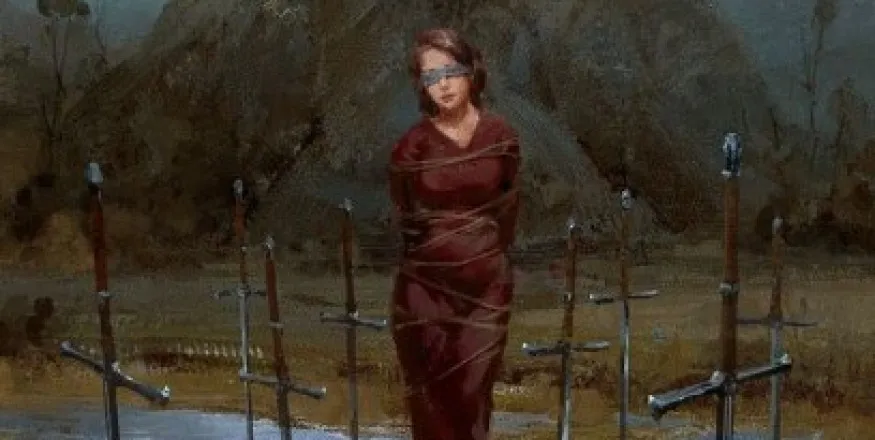Note for the reader: 18Please respect copyright.PENANA9blsfHxnuQ
My mother left me behind a box when she died. The box is labelled “The Beatrice Record”. Her name was not Beatrice. My name is not Beatrice. I know of no-one with that name. Inside the box are various texts and documents. Many unfinished. Many more unbegun, simply existing as disconnected titles or headings for phantom works. The true meaning of the collection escapes me, but I hope that one day, by documenting my findings here and creating a digital file on the works, I can draw some outsider help as to what it all means. I chose a random file titled “13 VW”.
18Please respect copyright.PENANA2Zszz6nTcN
13 VW
18Please respect copyright.PENANAurppxp8J91
When I was growing up, we were always told not to play on the 13 Virgin Wall. There was no explanation from our parents. There was no explanation from anyone. But all of the older folk in the village held firm that we should not play there. Did we listen to their warnings? Of course not. It was, and is, after all, just a wall.
The wall is quite short; it stretches between our village and the graveyard. There was no reason why we should play there, warnings or not. But something about the focus our parents and grandparents put onto that wall always attracted us to it. It was and is after all, just a stone wall.
This will not be your average horror story. There is nothing to fear about this wall. It is just a wall, but with some stories and legends which make it a great mystery to me. It isn’t even a classic ancient-looking thing made of stone or even bricks. It’s a plain, boring, concrete stretch. But still, there’s always been something about it which has drawn me back.
As children and teenagers, we would walk along the top of it, it was a tightrope, it was the plank of some old ship, it was whatever we made. Whenever a car would be heard or a walker or fellow, we would all duck on the other side, in a narrow passage between an electric fence and a dirty cow field – doing our best to stay hidden.
As I am older now, the reasons for dissuading us from it seem very obvious. Our village is not a big village – even back then before the recession – it was and is quite small. But the road to the graveyard is fast. And the dangers of this are obvious. Luckily, we were always too scared that a car round the corner would be one of our fathers, home and angry, so we always hid. Even as we turned teenagers. Doing our best to stay hidden.
I had returned to the village after many years of college. I was in the kitchen with my mom and asked her if she remembered us playing on the wall. She said she didn’t End of story? I think so. But later that day, when we were having tea out in the polytunnel, she was mulching something mid-cup and looked up and told me about the wall and why it was so regarded by all of the parents when we were younger.
My parents aren’t religious. They only went along and christened us because everyone else in the village was doing it. Many of the other families, she told me, were deeply scared of the legends associated with that wall. Following her re-telling of the legend, I asked her how old the legend really was, as the wall always looked modern. She replied that it was built in the early seventies, as far as she can tell. The context of this attached to the story truly shocked me.
Her story began in the village church. A marriage was being held between a local sweetheart and a handsome man from out of town. (She couldn’t give names for either yet could say that it took place on a Thursday.) It was discovered that one of the girl’s bridesmaids had been having an affair with her soon-to-be husband. When this was figured out, the priest was so outraged that he took to the highest point of the church and was heard bellowing some archaic chant. No-one could tell for sure who he was speaking to, or as to what he was saying.
Eventually the priest returned to the gathering, which now included both the wedding guests and locals, who had heard the commotion. There was a great swell of people crowding around the large oak doors. What was said inside, my mother isn’t sure of, whatever the case, it was seen that the priest was striding in the direction of the graveyard – his menacing figure casting a long shadow behind him. Beside him were some countrymen, and an altar boy, who had the bride and bridesmaid by the arms and were roughly shoving them onwards. They were both weeping and wailing.
It is a short walk from the church to the wall, taking about ten minutes, but by the time that they reached it, the girls had not ceased their tears, but had only increased and were in hysterics by the time they reached the wall. (In my mother’s version of the story, the priest ordered a thirteen-year-old girl to sit on the wall. He then said, “You see, she is pure”. Though this detail was left out of other stories that I would acquire later.)
He then ordered the ladies to sit just like the little girl had done. They, trembling, refused. He thus ordered the men to force the ladies down onto the cement surface. They obliged naturally, taking the priest’s word as gospel. At the moment which the ladies touched down on the stone, a gust of wind fell upon the precession. The ladies cried out in terror, begging for mercy before they dissolved into a dusty mist. The priest then turned to the people and said, “I prove my point.”
This is only one version of the story, however. Following my mother’s telling of it, my curiosity was peaked, and I inquired with some of the few remaining locals about their version of events. This was very interesting. The wife of the local grocer gave a version which was similar, though instead of two women, there were fourteen. And as it happened the priest had been the one to be having an affair with the bride. Of the fourteen, according to her, only one survived the wall and although she was not originally the bride, (and allegedly under fifteen!) she was married instead – as the groom couldn’t marry a cloud of dust.
Her sister, who was visiting from somewhere close, gave another version of the story. According to her, the women didn’t turn into mist, but rather statues, which were then removed by a local stonemason. That is why the wall has ugly ridges along its surface today. The husband came in from outside and waved his hand. This astute critique translated as “What a load of rubbish” and he did not share the sentiments of his wife. As far as he was concerned, that wall had no history.
I didn’t search for any further answers. As I said from the start, this isn’t meant to be a horror story. It is a collection of versions of events which probably didn’t even happen. From all of the sources, I never got the names of the bride and groom, or the priest. It was some time in the seventies. No-one claimed to have been there on that day, but all had had friends who were there. These friends have now long since passed away. Such is the way of such a village!
18Please respect copyright.PENANA5wIqB2NgeL






















